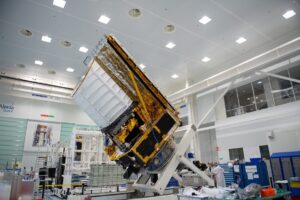The Euclid spacecraft will have a launch mass of around 2200 kg. It will be about 4.5 meters tall and 3.1 meters in ‘diameter’ (with appendages stowed). The nominal mission lifetime is six years.
The Euclid spacecraft will be made up of two major assemblies:
- payload module – houses the telescope, the focal plane components of the instruments and some of the data processing electronics;
- service module – contains the satellite systems: power distribution, attitude control, propulsion, telecommand, telemetry and data handling.

The structural and thermal model of the Euclid satellite at Thales Alenia Space’s premises in Cannes, France. Credit: ESA – S. Corvaja.
The service module (SVM) is under the responsibility of Thales Alenia Space (TAS). TAS is also responsible of the construction of the satellite which comprises the SVM and also the Paylaod Module (PLM).
The Payload Module (PLM) is under the responsibility of Airbus (Defence and Space). It comprises the telescope, the PLM thermal control system, the Fine Guidance Sensor (FGS), the VIS and NISP instruments (delivered to Airbus Defence and Space division by the Euclid Consortium) and the detectors (delivered by ESA).
The telescope is a 1.2 m on axis 3-mirror Korsch cold telescope providing a field of view of 1.25 x 0.727 deg2.
The visible (VIS) instrument has a focal plane composed of a matrix of 6×6 4096×4132 12 micron pixel e2v CCDs (Charge Coupled Devices), specially optimised for the Euclid mission. VIS will be equipped with one single very broad band filter covering the wavelength range from 550 nm to 900 nm with a mean image quality of about 0.23 arc-second.
